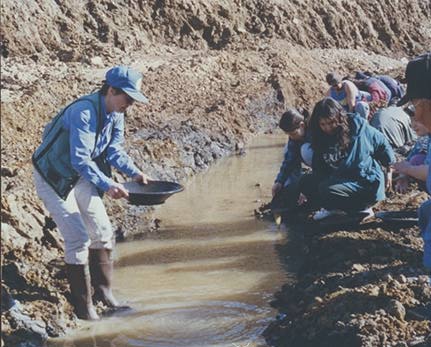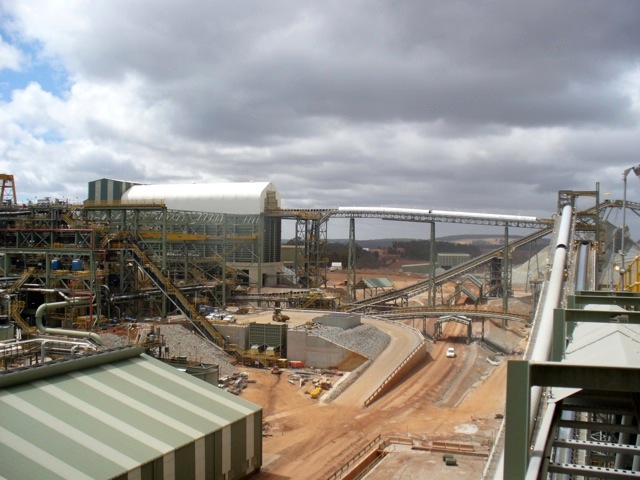Suite 580 – 625 Howe Street
Vancouver, B.C.
Canada V6C 2T6
Toll free: +1 888 955 4728
info@helioresource.com
NEWS RELEASE
Helio Makes a Significant New Gold-Copper-Silver Discovery at the Gold
Kop target, Damara Gold Project, Namibia
50m @ 2.1g/t Au, 0.8% Cu and 14g/t Ag
Includes 7m @ 9g/t Au, 4.4% Cu and 73g/t Ag
Vancouver, June 13, 2011
Helio Resource Corp. (TSX-V: HRC) is very pleased to report the first diamond
drill results from the current drill programme at the Gold Kop Target, on its 100%-
owned Damara Gold Project (DGP) in Namibia. The Gold Kop Target is situated
45km northeast of AngloGold Ashanti’s (AGA) Navachab gold mine (see map 1
attached).
Highlights
• 50m grading 2.1g/t Au, 0.8% Cu and 14.0g/t Ag
• Including 7m grading 9.0g/t Au, 4.43% Cu and 73.0g/t Ag
• Multiple mineralised horizons
• Mineralisation outcrops at surface and is open along strike and to
depth
• The intercept is located on the western margin of a 1.2km long IP
anomaly which is open to the north
• The intercept is also located within a 4km-long gold in soil anomaly
which is open to the southwest
• 2 drill rigs (1 diamond and 1 RC) currently active on the Gold Kop
target
These results are from the first hole of an ongoing 5,000m drill programme at the
Gold Kop Target. OJD1 was drilled to test a large geochemical and geophysical anomaly [see attached maps showing the location of the drill hole in relation to a 4km long gold-in-soil anomaly (Map 2) and a 1.2km long IP geophysical anomaly (Map 3)]. The hole intercepted a number of mineralised horizons, varying from wide zones representing bulk-mineable type targets to narrower high-grade
zones. A table of the significant intercepts from the hole is presented below.
The Gold – Copper – Silver mineralisation is hosted by a package of tremolitealtered marbles. There is a strong association with sulphides, mainly pyrite with chalcopyrite and pyrrhotite. The highest-grade mineralisation is associated with a zone of fresh massive and semi-massive sulphide and has a Specific Gravity of 4.14.
Drilling to expand and define this large zone of mineralisation is ongoing.
Management believes that this drill hole supports the potential for the Companyto make a significant new gold discovery only 45km away from AngloGoldAshanti’s Navachab mine.
Hole No. From Length
Au
(g/t)
Ag
(g/t)
Cu
(%) SG
OJD1 4 17 0.7 1.9 -
and 51 50 2.1 14.0 0.8 3.24
including 54 7 9.0 73.0 4.43 4.14
and* 129 20.8 0.25 - - 2.90
Historical drilling of Gold Kop
Since the late 1980s, previous explorers have conducted a limited amount of shallow reconnaissance drilling along the 4km-long Gold Kop gold-in-soil anomaly. Drilling results (for which copper-silver values were not reported) from the previous campaigns include:
• 1m at 71g/t Au;
• 7m @ 5.6g/t Au (open);
• 4m @ 8.6 g/t Au (open);
• 8m @ 3.0g/t Au;
• 34m @ 0.9 g/t Au.
Significant drill intercepts (>3m @ >2.0g/t Au) were recorded in AGA drill holes
over a 2.2km strike extent of altered marble and mineralisation is open along strike to the northeast and southwest and to depth.
The DGP Gold Project:
The DGP comprises four licences (covering 318,500ha or 3,185km 2), namely
Etjo South, Okakango, Wilhelmstal and Otjimbojo. Helio holds a 100% interest in
the project through its wholly-owned Namibian subsidiary, BAFEX Exploration
(Pty.) Ltd.
The DGP is located between AGA’s Navachab Mine to the southwest and Auryx
Gold Corp.’s Otjikoto Project to the northeast.The Navachab mine has been in production since 1989 and, as of December 2009, has produced approximately 1.5 Moz of gold and has a non-NI 43-101
compliant resource of 4.48 Moz grading 1.17g/t Au (source AngloGold Ashanti Quarterly Report, December, 2010).
Auryx’s Otjikoto Gold Project, located approximately 150km northeast of Helio’s licences has a NI43-101 indicated resource (February, 2011) of 15.78Mt grading 1.94g/t Au and an inferred resource of 8.37Mt grading 1.94g/t Au for total of 1.5 Moz at a 0.8g/t cut-off. The 5,000m drill programme, which is the first time the Gold Kop anomaly has been systematically drilled, is part of the 10,000m of drilling programme outlined for the DGP in 2011 (see Company’s news release dated January 13, 2011).
About Helio
Helio Resource Corp. is a well financed gold exploration company focused on increasing the initial NI 43-101 compliant resource at the SMP Gold Project in Tanzania and outlining the resource potential at the Damara Gold Project in Namibia. In November 2010, Helio released an encouraging initial resource estimate for the SMP: Measured and Indicated Resource of 588,749 ounces (11.82Mt grading 1.54g/t Au) plus an Inferred Resource of 352,354 ounces (9.9Mt grading 1.10g/t Au) at a cut off grade of 0.3g/t Au.
Chris MacKenzie, M.Sc., C.Geol., Helio’s COO and a Qualified Person as designated by NI 43-101, is based in Namibia and supervises the exploration at Helio’s projects, including the sampling and quality assurance / quality control (QA-QC) programmes, and has reviewed the contents of this news release. Hole OJD1 was drilled southwards at -60º. Intercepts are reported as drilled widths; more drilling is required to determine true widths. The hole was continuously sampled at 1m intervals. Samples were split with a core saw and one half was retained on site. All samples were submitted to the lab with internal QA/QC checks including the use of standards (ave. 1 every 18 samples) and duplicates
(ave. 1 every 25 samples). Samples were assayed at the Intertek Genalysis Laboratory in Johannesburg, South Africa by 50g fire assay for gold, and by Atomic Absorption for Copper and Silver. As well as the Company’s internal QA/QC programme, Intertek Genalysis also applied their own internal QA/QC
programme, consisting of insertion of standards and duplicates. Weighted average intercepts are calculated using a 0.5g/t Au cut-off (except for the zone from 129m, which has a 0.2g/t Au cut-off) and may include some mineralised waste. Highest individual 1m assays were 18.1g/t Au from 54m, 5.6% Cu from 57m and 99.0g/t Ag from 58m.
For additional information, please contact Richard Williams or Irene Dorsman at +1 604 638 8007 or by e-mail to richard@helioresource.com or irene@helioresource.com.
ON BEHALF OF THE BOARD OF DIRECTORS
“Richard D. Williams” “Chris MacKenzie”
Richard D. Williams, P.Geo Christopher J. MacKenzie, C.Geol. CEO COO
Neither the TSX Venture Exchange nor its Regulation Services Provider (as that term is defined in the
policies of the TSX Venture Exchange) accepts responsibility for the adequacy or accuracy of this release MAP 1 Location of Gold Kop Target, centrally located within Helio’s Otjimbojo LicenceMAP 2 Location of hole OJD1 in relation to Geochemical Anomaly (backdrop is of aster image mapping out carbonate horizons, historical drill intercepts also shown).MAP 3 Location of hole OJD1 in relation to IP Anomaly.




















